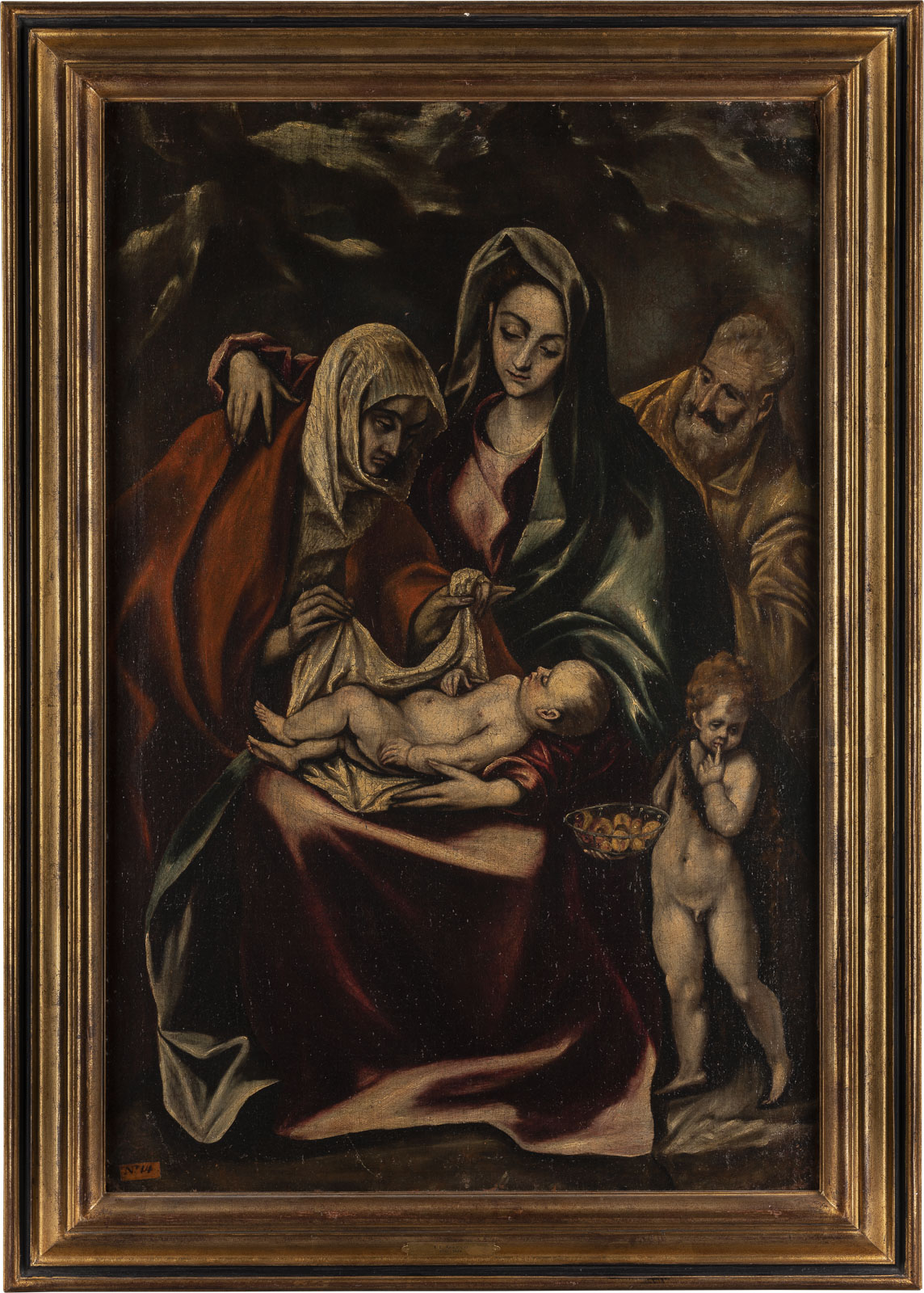Auction 112 / Lot 2613
Title
HOLY FAMILY WITH ANNA AND JOACHIM
Artist
EL GRECO (THE GREEK) ('PROPERLY: DOMINIKOS THEOTOKÓPOULOS')
Artist Data
1541 Candia on Crete - 7. April 1614 Toledo
Origin
c. 1585
Technique
Oil on canvas
Dimension
102,5 x 67 cm (frame 120,5 x 84,5 cm)
Reserve price
Hammer price
Description
Some artists are lucky enough to receive approval and praise for their work within their own lifetime. Others never experience it and still others are reborn with the reception of their art centuries later. Thus the originally Greek-Byzantine icon painter Domínikos Theotokópoulos - El Greco - who actually sought to turn away from the classical norms of modern times through his art in the style of Spanish Mannerism, experienced his own renaissance at the beginning of the 20th century. His newfound public celebrated him as a pioneer of modern art, as he had had a decisive influence on the work of numerous artists of that era. His modern painting style is also reflected in the painting of the Holy Family with Anna and Joachim. In this depiction, El Greco positions the group of five people in front of an effervescent black and grey background. Contrary to the rhythmic, gentle figure composition of the Renaissance masters, he presents the Holy Family in intimate intimacy, closely united with each other.Mary sits in the centre, flanked by Anna and Joachim, and carries the sleeping baby Jesus on her lap.Gently supporting the naked boy from below with one hand, she lovingly places her right hand around her mother's shoulders, her graceful lips drawn into a gentle smile.Anna seems to be carefully covering the boy with a white cloth.Like Mary's gaze, Anna's eyes fall on the infant Jesus in admiration and emotional tenderness. Joachim also gazes at the boy in silent adoration over Mary's shoulder.To Mary's right stands St John in boy's form, looking down and commanding silence with his finger.He seems to be offering a bowl of fruit to the group with his right hand.El Greco uses broken colours for the colour scheme of the clothes: Saint Anne's red cloak contrasts Mary's greenish-blue robe in a complementary way.This could stand for the individuality of the two women, especially in relation to the separation through the generations.Mary's reddish tunic, however, once again links mother and daughter in their maternal role. Joachim wears an off-white yellow. This depiction of the Holy Family is a prime example of El Greco's religious works.The absence of any glorification through halos or comparable attributes lends the painting an intimacy and normality that allows identification with the Holy Family. With his expressive, affect-laden compositions, El Greco balances the compositionally gentle waves of the old Renaissance masters and gives his oeuvre a contemporary, unique character through his elongated bodies, faces and limbs.In the spirit of Spanish Mannerism, he adopts the figural ideal of the figura serpentinata with its screwed turning movements and sets them in interaction with the vibration of his colouring.Sulfurous yellows, pale blues and cold reds contrast the vivid colours typical of the Renaissance, while his figures - sometimes almost pale as corpses - oscillate in shades of grey and pink.''El Greco shook up the ashlar construction of the Renaissance with its one-sided formalism.The Renaissance no longer knew what soul meant, no longer knew the longing for the infinite, the metaphysical.''(Hugo Kehler, ''The Art of Greco'', 1920, third edition, preface). In a way, he breathed his spirit and soul into modernity. We would like to thank Mrs. Anne Haußmann for providing this beautiful catalogue contribution. Literature: J. Camon Aznar, Dominico Greco, Madrid 1950 p. 579 fig. 431 and fig. 437; J. Camon Aznar, Dominico Greco, Madrid 1970, second edition, two volumes, p. 584 and fig. 473 K. Ipser, El Greco p. 375 Scientific examination of the painting materials by Prof. Dr. Elisabeth Jägers, Dipl. Chem. and Dr. Erhardt Jägers, Dipl. Chem. Loaned to the Museum Kunstpalast, Düsseldorf between August 2012 and July 2013.Provenance: Collection Marques de Villalonga Sevilla; World Exhibition Ibero Americana 1928, No. 34, Collection Vda.De Alvares de Toledo; Marques de Lianes Collection, Madrid (H. Söhner); Private Collection Madrid (Camon Aznar 1950); J. Bernhardt Collection, Buenos Aires (Camon Aznar 1970); Bernhardt Collection (Karl Ipser, p. 375); Private Collection Brussels. Provenance: Important Rhenish private collection.

